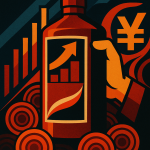Key Points
- OPEC+ is increasing oil production by an additional 548,000 barrels per day starting in September, aiming to fully reverse last year’s production cuts.
- A major driver for this increase is the ongoing pressure on Russian oil supply due to sanctions and reduced price caps by the EU.
- Despite Western pressure, India remains committed to purchasing Russian oil, which once constituted nearly 40% of its total imports.
- Analysts, including those from Commerzbank (Shangye Yinhang 商业银行) and JPMorgan Chase (Mogen Dapu 摩根大通), warn that despite increased OPEC+ supply, effective sanctions on Russia could lead to a significant increase in oil prices, estimating 2.75 million barrels per day of Russian crude at risk.

The latest OPEC+ oil production decision is in, and it’s a big one for the global energy market.
Sources inside the influential oil cartel confirmed that eight member countries have agreed to boost daily oil production by a significant 548,000 barrels starting this September.
This move continues a trend of increasing supply, but the geopolitical backdrop is more complicated than ever.
So, what’s really driving this decision, and what does it mean for oil prices and Russia’s role as a key energy supplier?
Let’s break it down.
The Big News: OPEC+ Is Opening the Taps
The decision was hammered out in a Sunday meeting, with the next one already on the calendar for September 7th.
Here’s the high-level view of the production increases this year:
- April: +138,000 barrels per day
- May, June, July: +411,000 barrels per day (each month)
- August: +548,000 barrels per day
- September (planned): +548,000 barrels per day
If the September increase goes through as planned, OPEC+ will have completely reversed the production cuts it committed to last year.
The organization, which collectively accounts for about half of the world’s oil production capacity, is also planning a broader assessment of its strategy by the end of December, reviewing a total production increase plan of 1.66 million barrels per day.

Resume Captain
Your AI Career Toolkit:
- AI Resume Optimization
- Custom Cover Letters
- LinkedIn Profile Boost
- Interview Question Prep
- Salary Negotiation Agent

The Elephant in the Room: Russia’s Squeezed Supply
- US Requests to India: United States has reportedly asked India to cease purchasing Russian oil.
- EU Sanctions & Price Cap: The European Union has implemented a new round of sanctions, specifically lowering the price cap for buyers of Russian crude.
- Geopolitical Pressure: Coordinated international efforts to reduce Russia’s energy revenues.
A huge driver behind this production hike is the mounting pressure on Russian oil supply.
The geopolitical chess match is heating up.
There are reports the United States has asked India to stop buying Russian oil.
Simultaneously, the European Union has hit Russia with a new round of sanctions, specifically lowering the price cap for buyers of Russian crude.
This two-pronged approach is designed to squeeze Russia’s energy revenues.

India’s Bold Stance: “We’re Still Buying”
Despite the pressure from the West, India is holding its ground.
The Indian Ministry of External Affairs has made it clear: India will continue to purchase oil from Russia.
Randhir Jaiswal, a spokesperson for the ministry, stated that India’s priority is securing its own energy needs based on global supply and the current international situation.
This isn’t surprising, given the numbers.
According to data analytics firm Kpler, Russian oil supply once made up nearly 40% of India’s total imports, making Russia its single largest crude supplier.

Find Top Talent on China's Leading Networks
- Post Across China's Job Sites from $299 / role, or
- Hire Our Recruiting Pros from $799 / role
- Qualified Candidate Bundles
- Lower Hiring Costs by 80%+
- Expert Team Since 2014
Your First Job Post

The Million-Dollar Question: Will Oil Prices Rise or Fall?
- Commerzbank (Carsten Fritsch): OPEC+ cannot fully replace Russian oil supply; effective sanctions could lead to “significant increase in oil prices.”
- JPMorgan Chase (Mogen Dapu 摩根大通): Estimates 2.75 million barrels per day of Russian seaborne crude at risk due to U.S. sanction threats.
- DBS Bank (Suvro Sarkar): Resolution of trade agreements has been a primary driver of rising oil prices; positive U.S. trade progress could further boost confidence.
For years, OPEC+ kept production tight to support market prices.
But this year marked a strategic pivot.
The group shifted its focus to regaining market share, partly in response to calls from former U.S. President Trump for more production.
While adding over half a million barrels a day sounds like it should drop prices, the situation isn’t that simple.
Analyst Take: Why Prices Could Still Spike
Experts are warning that the increased OPEC+ supply might not be enough to offset a potential drop in Russian exports.
Carsten Fritsch, an analyst at Commerzbank (Shangye Yinhang 商业银行), puts it bluntly: OPEC+ cannot fully replace Russia’s oil supply.
He believes that if sanctions against Russia are truly effective, we could see a “significant increase in oil prices.”
JPMorgan Chase (Mogen Dapu 摩根大通) backs this up with some serious numbers.
They estimate that U.S. threats to sanction Russian oil could put 2.75 million barrels per day of Russian seaborne crude at risk.
The Trade & Tariff Wildcard
On top of everything else, the market is anxiously watching U.S. tariffs, which are set to take effect on August 7th.
Suvro Sarkar of DBS Bank (Xingzhan Yinhang 星展银行) noted that the resolution of trade agreements has been a primary driver of rising oil prices recently.
Any further positive progress from the U.S. on trade could inject even more confidence into the oil market, potentially pushing prices higher.
Final Thoughts: Uncertainty Is the Only Certainty
The global oil market is at a fascinating crossroads.
OPEC+ is increasing its oil production to calm markets and regain share, but the massive geopolitical variable of sanctions on Russian oil could throw everything into chaos.
While more supply is on the way, the potential for a major supply shock from Russia means the risk of a significant price surge remains firmly on the table.
Keep an eye on the September 7th OPEC+ meeting and the ripple effects of international sanctions—this story is far from over. This is a crucial moment for OPEC+ oil production and the global economy.




